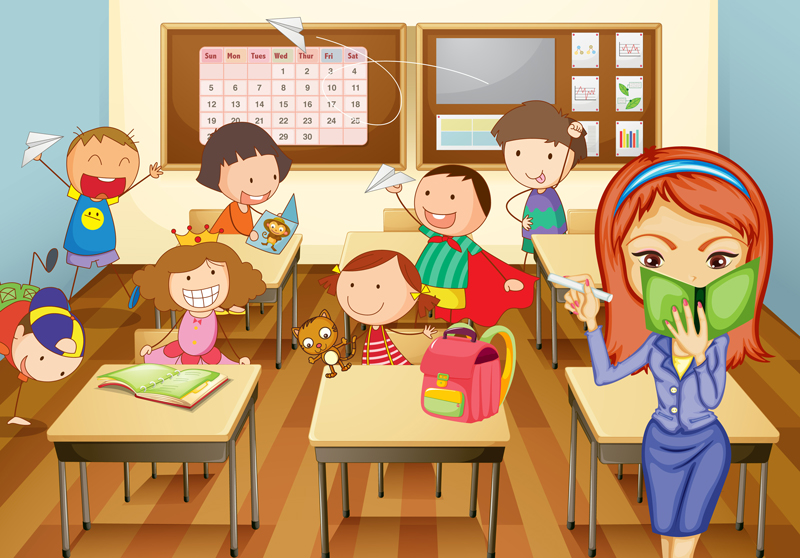Classroom Management is the various skills and techniques that instructors use to keep students organized, orderly, focused, attentive, on task, and academically productive during a class.
When classroom-management strategies are executed effectively, teachers minimize the behaviors that impede learning for both individual students and groups of students, while maximizing the behaviors that facilitate or enhance learning. In general, effective teachers tend to display strong classroom-management skills, while the hallmark of the inexperienced or less effective teacher is a disorderly classroom filled with students who are not working or paying attention.
- Traditional interpretation of effective classroom management: may focus largely on “compliance”—rules and strategies that teachers may use to make sure students are sitting in their seats, following directions, listening attentively, etc.
- Updated view of classroom management: extends to everything that teachers may do to facilitate or improve student learning, which would include such factors as behavior(a positive attitude, happy facial expressions, encouraging statements, the respectful and fair treatment of students, etc.),environment (for example, a welcoming, well-lit classroom filled with intellectually stimulating learning materials that’s organized to support specific learning activities),expectations (the quality of work that teachers expect students to produce, the ways that teachers expect students to behave toward other students, the agreements that teachers make with students), materials (the types of texts, equipment, and other learning resources that teachers use), or activities (the kinds of learning experiences that teachers design to engage student interests, passions, and intellectual curiosity).
- Poorly designed lessons, uninteresting learning materials, or unclear expectations, for example, could contribute to greater student disinterest, increased behavioral problems, or unruly and disorganized classes,
- Classroom management cannot be easily separated from all the other decisions that teachers make. Good teaching and good classroom management become, to some degree, indistinguishable.
- In practice, classroom-management strategies may appear deceptively simple, but successfully and seamlessly integrating them into the instruction of students typically requires a variety of sophisticated techniques and a significant amount of skill and experience.
Techniques
- Entry Routine is a technique in which teachers establish a consistent, daily routine that begins as soon as students enter the classroom—preparing learning materials, making seat assignments, passing in homework, or doing a brief physical “warm-up” activity would all be examples of entry routines. This technique can avoid the disorder and squandered time that can characterize the beginning of a class period.
- Do Now is a brief written activity that students are given as soon as they arrive in the classroom. This technique is intended to get students settled, focused, productive, and prepared for instruction as quickly as possible.
- Tight Transitions is a technique in which teachers establish transition routines that students learn and can execute quickly and repeatedly without much direction from a teacher. For example, a teacher might say “reading time,” and students will know that they are expected to stop what they are working on, put away their materials, get their books, and begin reading silently on their own. This technique helps to maximize instructional time by reducing the disarray and delay that might accompany transitions between activities.
- Seat Signals is a technique in which students use nonverbal signals while seated to indicate that they need something, such as a new pencil, a restroom break, or help with a problem. This technique establishes expectations for appropriate communication and helps to minimize disruptions during class.
- Props is the act of publicly recognizing and praising students who have done something good, such as answering a difficult question or helping a peer. Props is done by the entire class and is typically a short movement or spoken phrase. The technique is intended to establish a group culture in which learning accomplishments and positive actions are socially valued and rewarded.
- Nonverbal Intervention is when teachers establish eye contact or make gestures that let students know they are off-task, not paying attention, or misbehaving. The technique helps teachers efficiently and silently manages student behavior without disrupting a lesson.
- Positive Group Correction is a quick, affirming verbal reminder that lets a group of students know what they should be doing. Related techniques are Anonymous Individual Correction, a verbal reminder that is directed at an anonymous student; Private Individual Correction, a reminder given to an individual student as discretely as possible; and Lightning-Quick Public Correction, a quick, positive reminder that tells an individual student what to do instead of what not to do.
- Do It Again is used when students do not perform a basic task correctly, and the teacher asks them to do it again the correct way. This technique establishes and reinforces consistent expectations for quality work.
